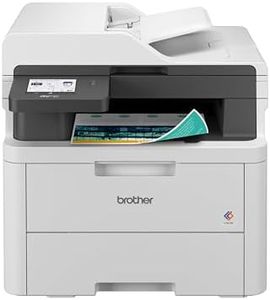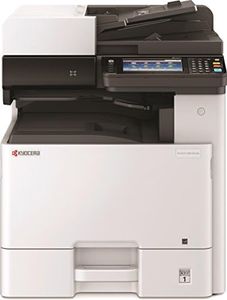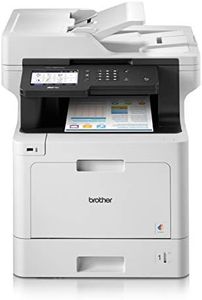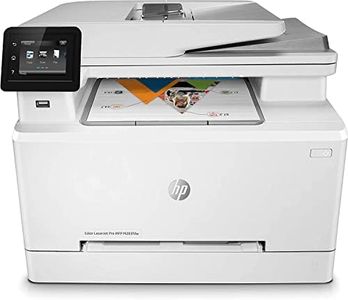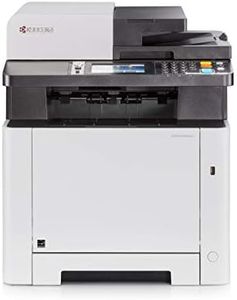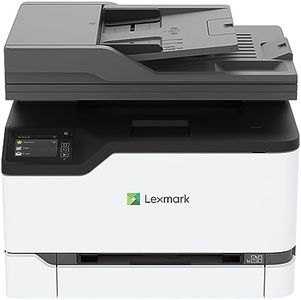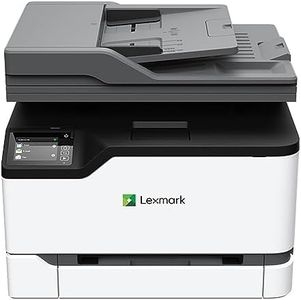We Use CookiesWe use cookies to enhance the security, performance,
functionality and for analytical and promotional activities. By continuing to browse this site you
are agreeing to our privacy policy
7 Best Color Laser All In One Printers
From leading brands and best sellers available on the web.Buying Guide for the Best Color Laser All In One Printers
Choosing a color laser all-in-one printer can feel overwhelming because there are many features to consider, but understanding your specific needs will help narrow down your options. Whether you're printing, scanning, copying, or faxing, it's important to seek a balance between print quality, speed, functionality, and connectivity to ensure the printer fits smoothly into your daily routine.Print ResolutionPrint resolution, usually measured in dots per inch (DPI), tells you how sharp and detailed your printed documents and images will be. Higher DPI values mean better print quality, which is especially noticeable in images and graphics. Low DPI (around 600 x 600) is fine for standard text documents, while higher DPI (1200 x 1200 or above) improves color depth and detail in photos. If you often print detailed images or graphics, choose a higher resolution. For basic documents, a modest resolution is sufficient.
Print SpeedPrint speed indicates how many pages the printer can produce per minute (ppm). Fast print speeds save you time if you print large volumes regularly, but may be less important for occasional use. Printers are typically grouped into slower speeds (up to 20 ppm), mid-range (20–30 ppm), and high speed (over 30 ppm). If your home or office deals with lots of printing daily, a higher speed can make a big difference. For lighter use, a lower speed is usually enough.
Scanning and Copying FeaturesAn all-in-one printer's scanning and copying abilities vary widely and include factors like resolution, auto document feeder (ADF), and duplex scanning. Higher scanning resolutions help capture more detail in your scans, while an ADF allows you to scan or copy multipage documents automatically. Some models offer double-sided scanning, which saves time. If you scan or copy multipage or double-sided documents often, look for these features. For occasional single-page tasks, basic scanning suffices.
Paper HandlingPaper handling covers how much paper the printer’s tray can hold, what paper sizes it supports, and special features like duplex (double-sided) printing. High-capacity trays are convenient for heavy users, while duplex printing saves paper and is great for longer reports. Some printers also handle various paper types, like envelopes or labels. Consider your typical print volume and media needs—choose larger capacity and duplex features if you print a lot or use different paper types.
Connectivity OptionsConnectivity is about how your devices communicate with the printer. Options include USB for wired use, Ethernet for network connections, Wi-Fi for wireless printing, and sometimes even mobile printing or cloud features. Wireless options add flexibility and allow printing from multiple devices or locations. If you want to print from smartphones or use the printer within a team, look for wireless and mobile support. For solo or direct connections, basic USB works fine.
Monthly Duty CycleMonthly duty cycle tells you the maximum number of pages the printer is designed to handle in one month. It’s not how much you should print, but the upper safe limit. Printers are classified with lower (up to 1,000 pages), medium (up to 10,000 pages), and high (over 10,000) cycles. If you expect frequent, heavy use, opt for a printer with a higher duty cycle to ensure reliability and avoid wear. Light users can comfortably settle for a lower-rated model.
Operating Costs (Consumables)Operating costs refer to how much you spend over time on toner, drums, and other consumables. Some printers use high-yield cartridges that can reduce long-term costs, while others might have frequent replacements. Calculating the cost per page helps compare models. If you print a lot, choosing a model with efficient consumables can save money and reduce hassle, while lighter users may not notice as much difference.
User Interface and Ease of UseThe user interface includes the printer’s display panel, buttons, or touchscreen controls. Simple, intuitive controls make setting up and using the printer much easier, especially for scanning or copying features. Some models offer colored touchscreens, while others have basic button layouts. If you prefer clear menus and easy navigation for all features, look for models known for user-friendly interfaces. Simpler designs work if you’re comfortable with basic functions or don’t need advanced options.
